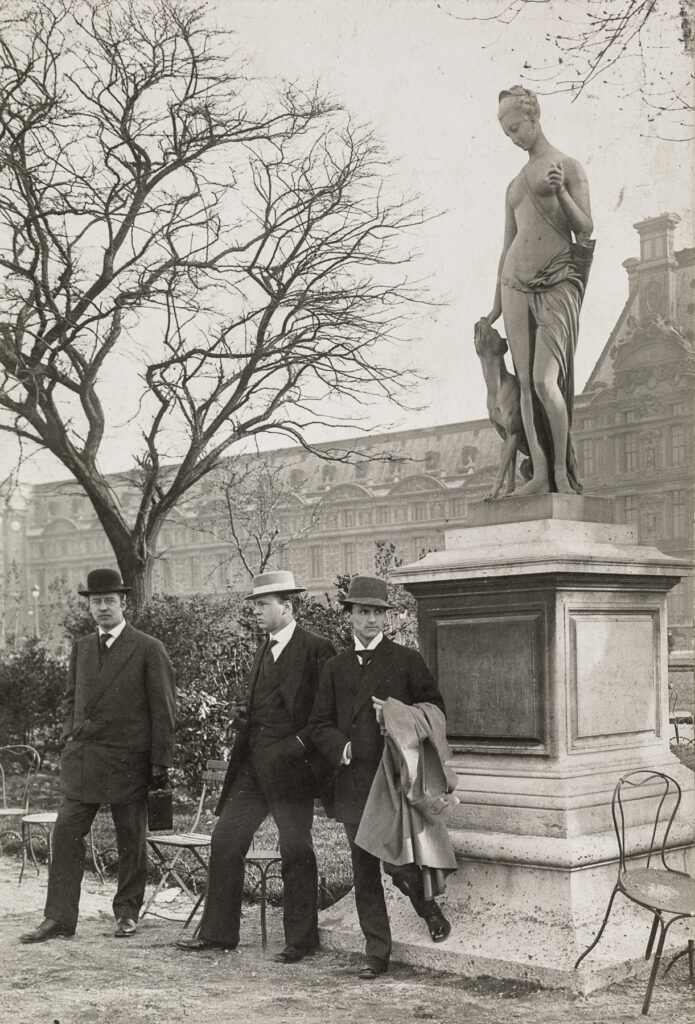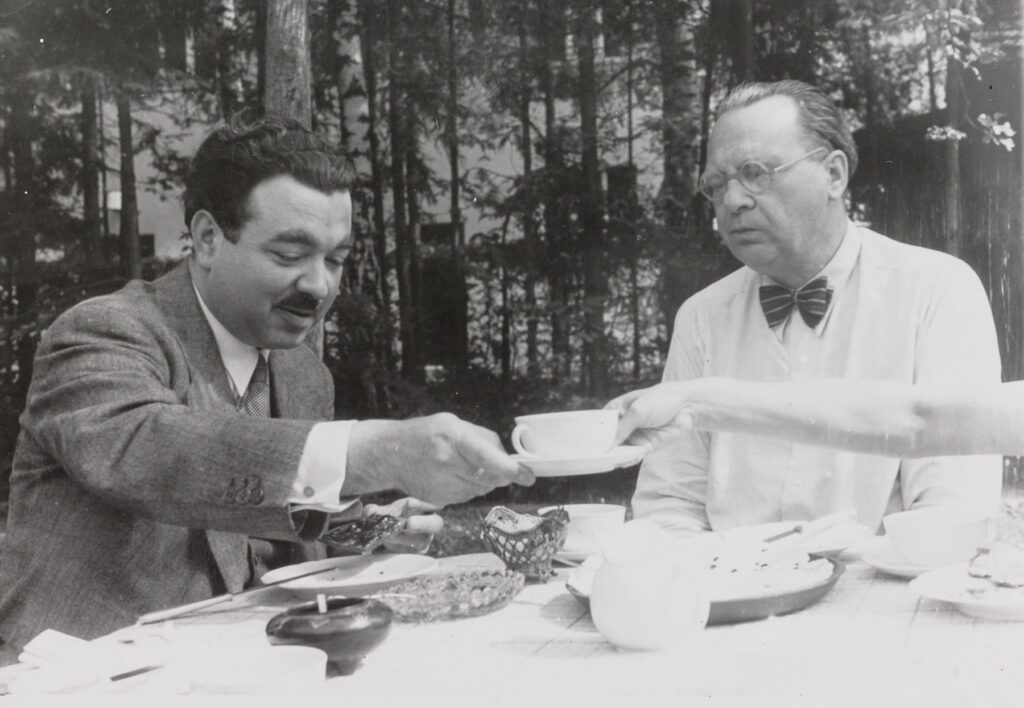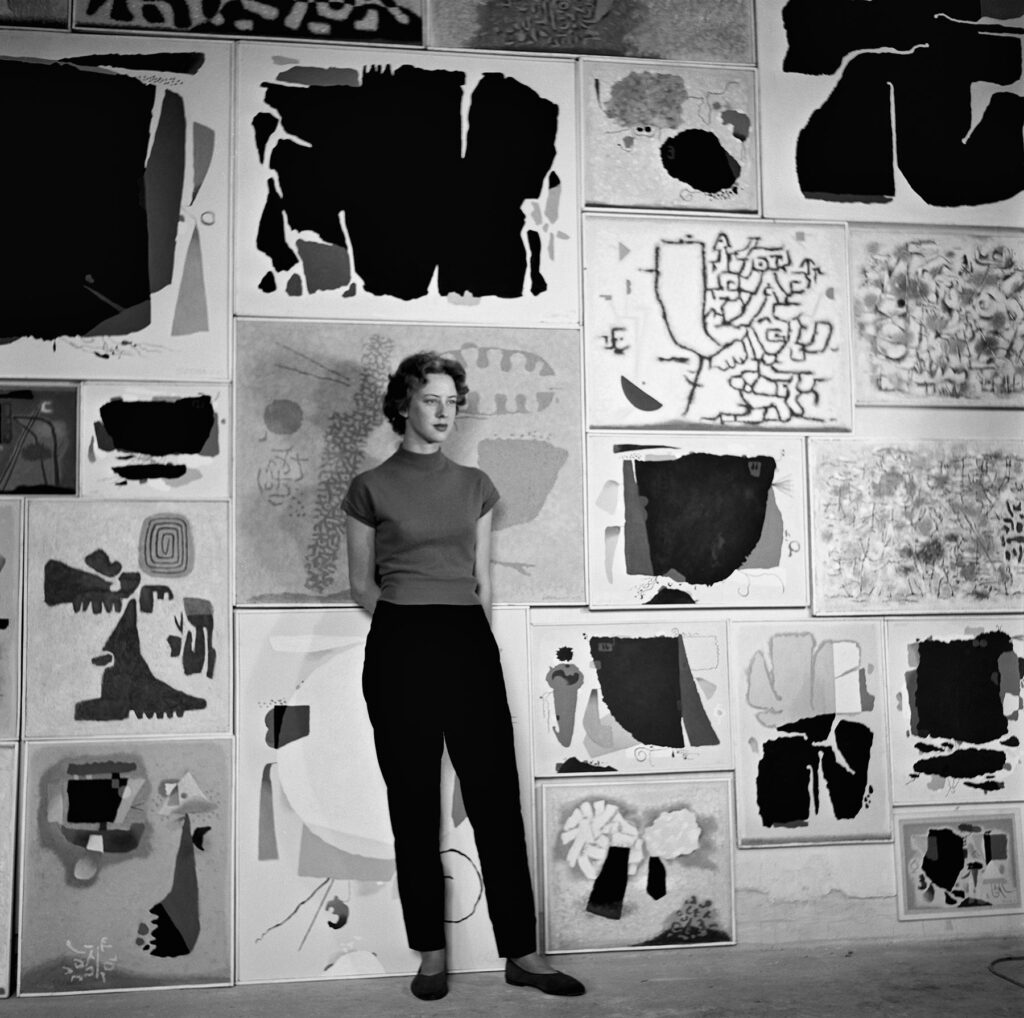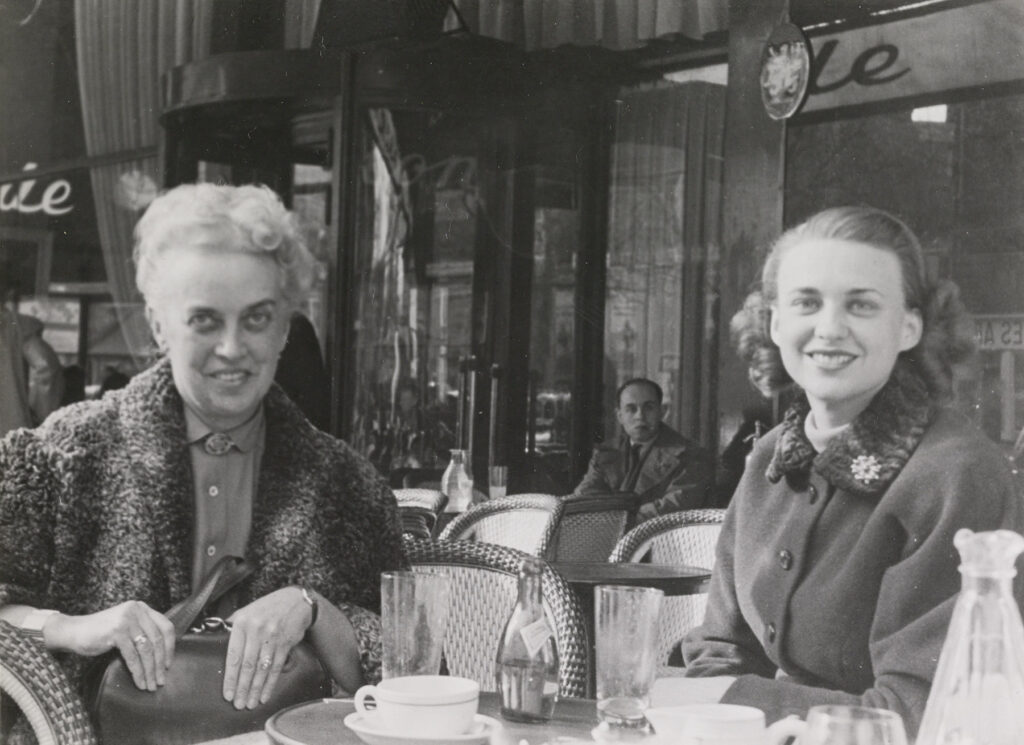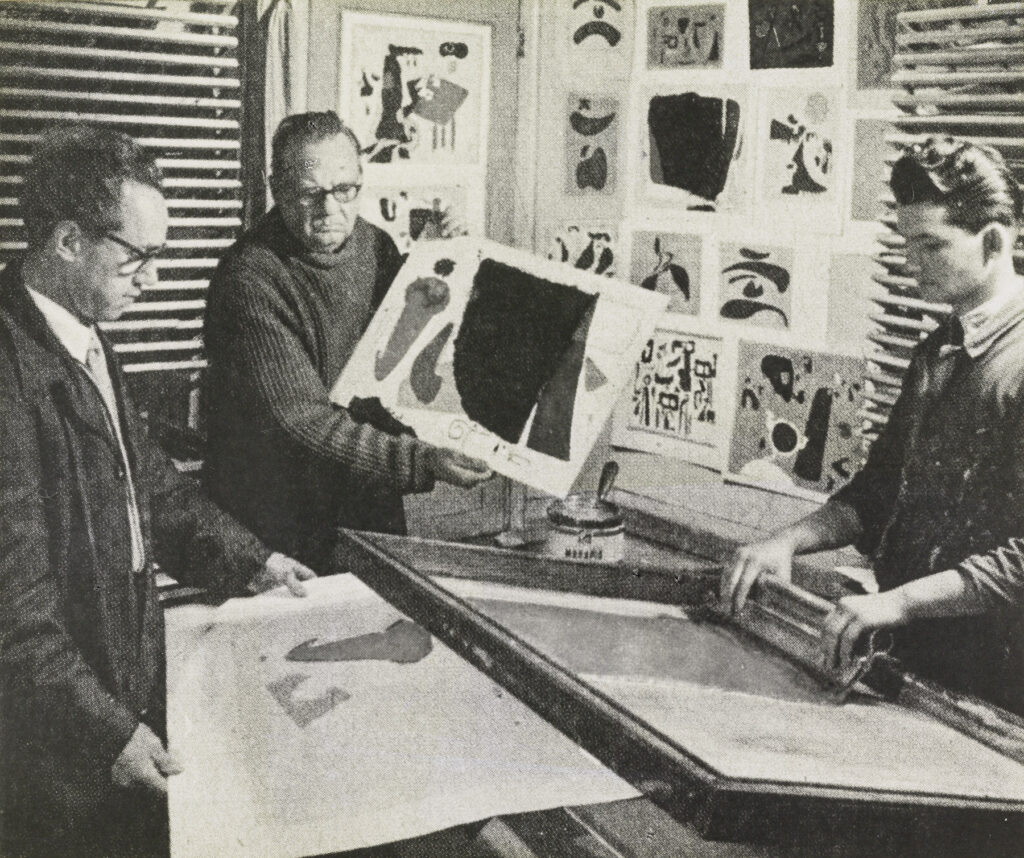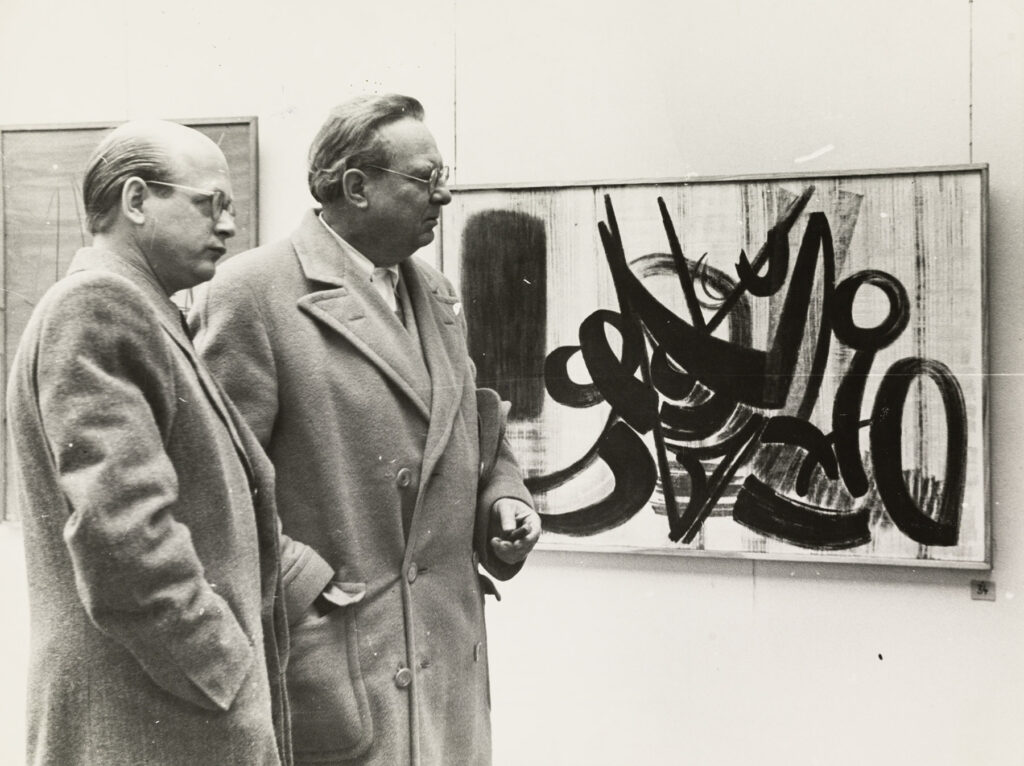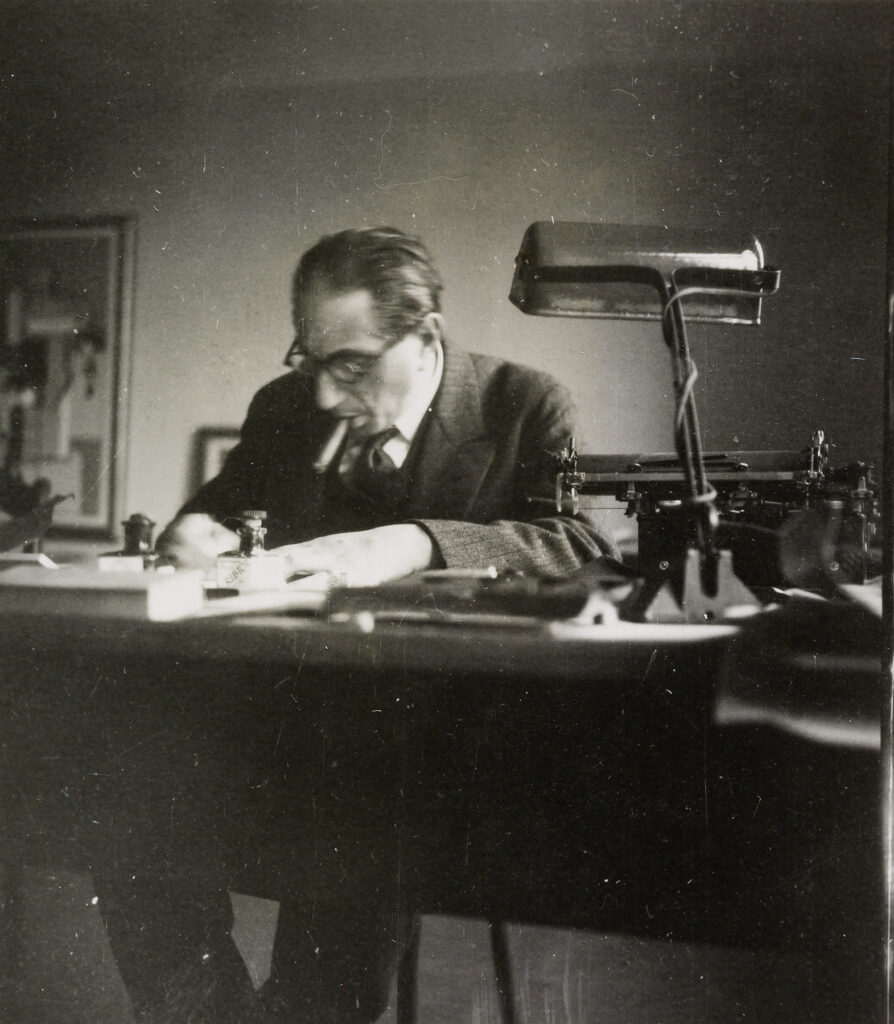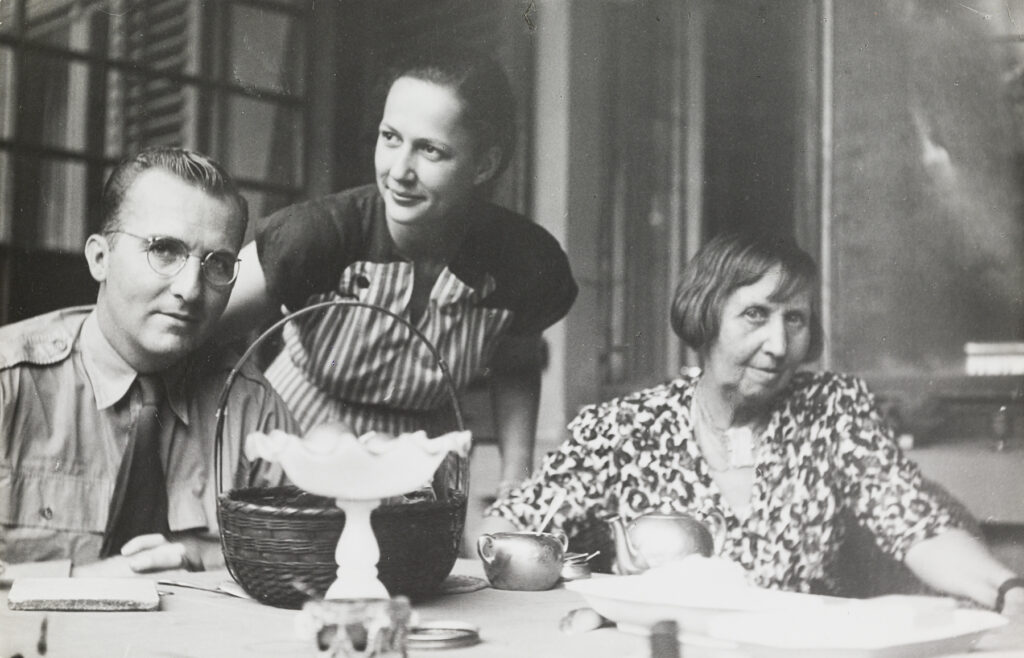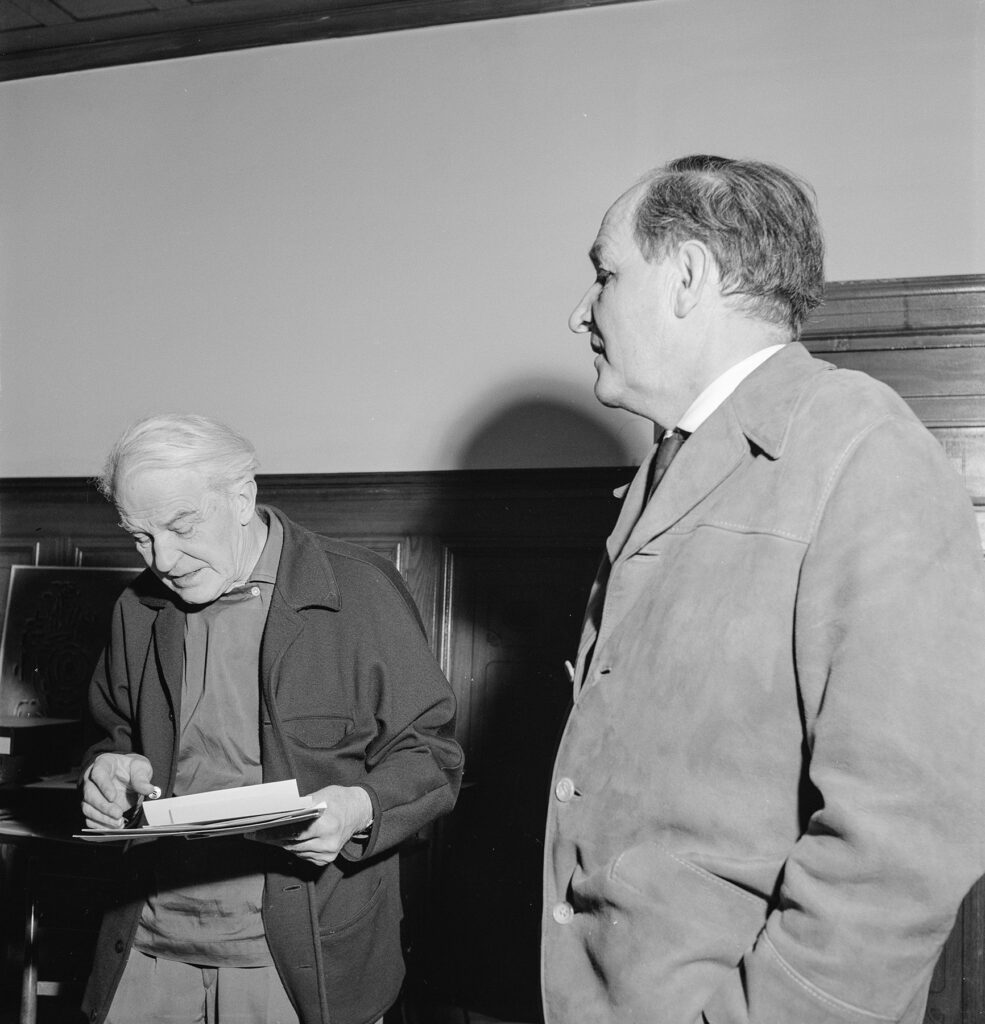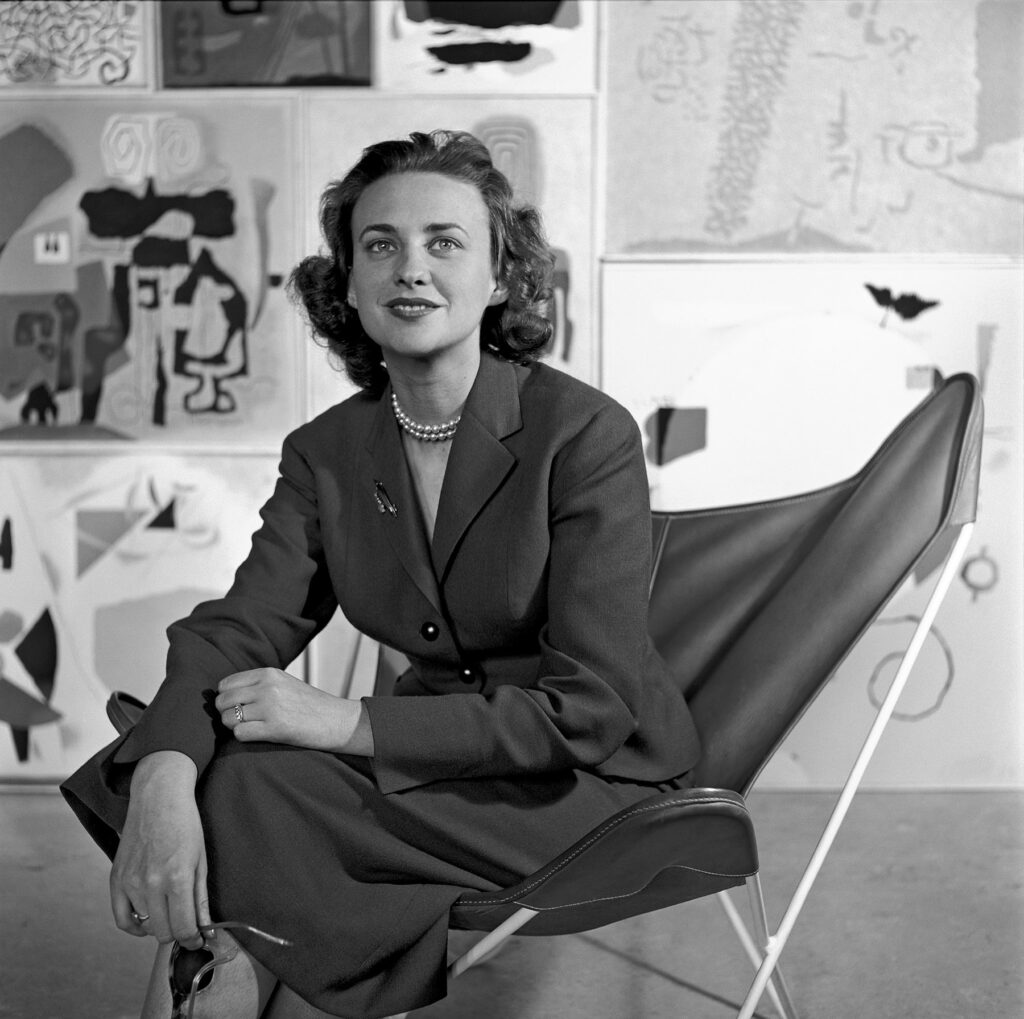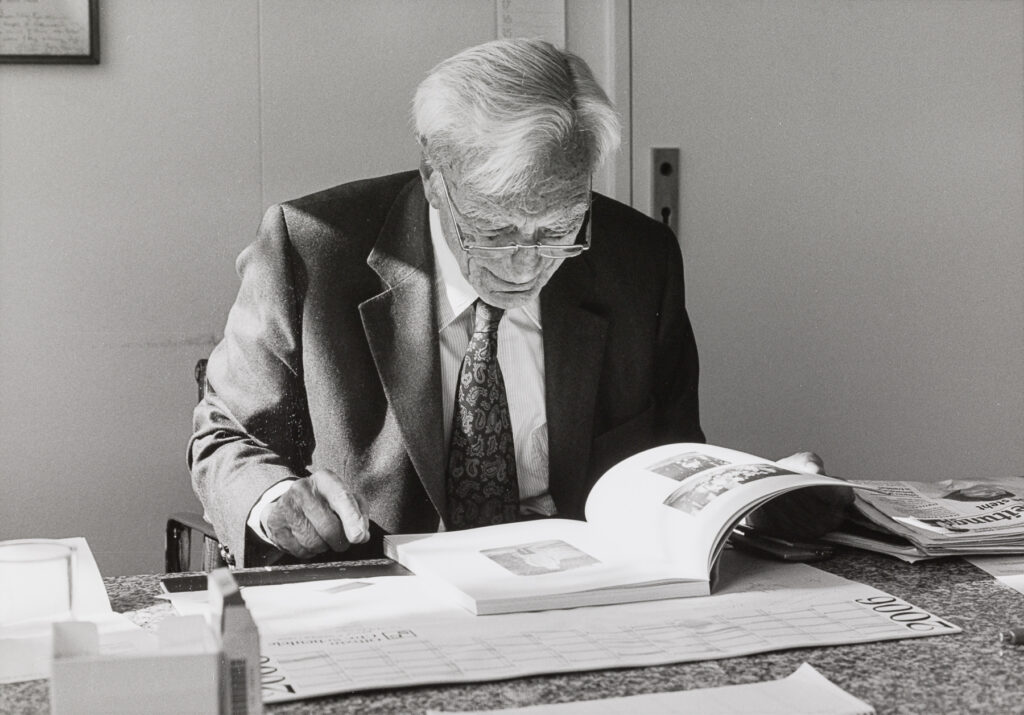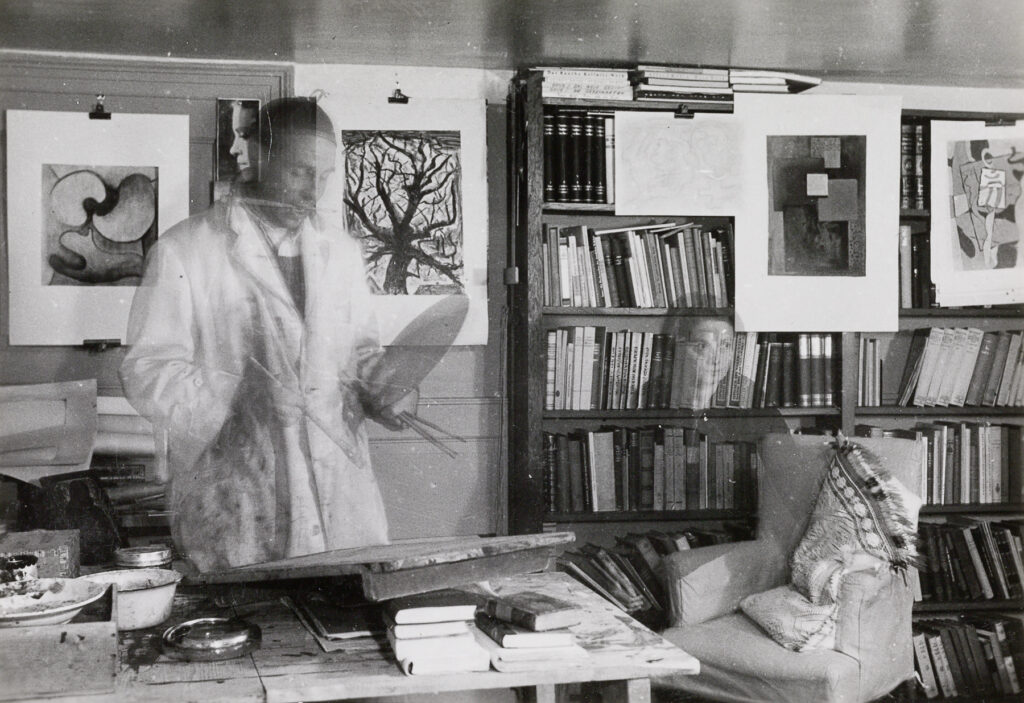Briefly presented here on a continual basis will be all those patrons, collectors, supporters, and friends with whom Willi Baumeister collaborated, who influenced him, or in some other way crossed his path as an artist. This list will be continually expanded.
A–Z
Wilhelm (Wil) F. Arntz
Wilhelm (Wil) F. Arntz (1903 to1985) was a German writer, publisher-bookseller, editor, and expert of 20th-century art. After studying jurisprudence in Munich, Berlin, and Frankfurt am Main, he became an assistant to Prof. Köbner, a lawyer specializing in international law who was married to a daughter of Max Liebermann. In this way he first came into contact with art. In 1937 he was arrested by the Gestapo in Berlin. From 1939 to 1944, he was active as a freelance writer. At this time he began collecting expressionist art. Following war captivity, Arntz met with his family again in Stuttgart in 1945. They had agreed: After the war we will meet at Baumeister’s. Between 1947 and 1978, he was employed at the Ketterer and Lempertz art auction houses in Stuttgart and Cologne, respectively. Beginning in 1945, Arntz built up an extensive library on 20th-century art. Fifty-thousand books later went to the Getty Museum in Los Angeles. His acquaintance with Baumeister began in Frankfurt in 1932. Baumeister noted on May 31, 1933: Wilhelm Arntz editor and good fellow. In 1946, Arntz and the publisher Hatje provided an expert opinion on the illustration cycle to Shakespeare’s Tempest that Baumeister had drawn during the war. In 1954, he wrote in the commemorative publication for Baumeister on his sixty-fifth birthday under the title Baumeister-totally concrete.
Felicitas Baumeister
Felicitas Baumeister (born 1933) is one of Willi and Margarete Baumeister’s two daughters. She grew up in Stuttgart until the family left the city in 1943 to escape the air raids and moved to Urach. At the end of the war, the family returned to Stuttgart. Felicitas attended Hölderlin Grammar School until 1950, and in 1951 took her first trip to Paris, city of fashion. She passed her final state examination at comercially oriented Women’s Technical College (Frauenfachschule), commercially oriented, and successfully completed her apprenticeship in dressmaking in 1955. After her father’s death in 1955, Felicitas – together with her mother and her sister Krista – embarked upon the curation of his art estate. By 1956 she had implemented an exhibition originally planned by Baumeister himself at the Kleemann Galleries in New York. Felicitas married business economist Roland Karg in 1958, and set to work building up her husband’s company. In 1989, she took part in Jochen Canobbi’s film about Willi Baumeister. In 2005 Felicitas Baumeister and Jochen Gutbrod decided to affiliate the Baumeister Archive , so-called since the 1970s, with a public institution – as a result the archive went to the Stuttgart Museum of Art. The Willi Baumeister Foundation GmbH was established in 2008, with Felicitas Baumeister chairwoman of the curatorium. In 2010 she was appointed honorary senator (Ehrensenatorin) of the Academy of Fine Arts in Stuttgart. The e‑book “Willi Baumeister, Schöpfer aus dem Unbekannten” (Willi Baumeister, Creator from the Unknown) by Brigitte Pedde was published in 2013 upon Felicitas’ initiative. Her commitment to numerous exhibitions and catalogues raisonnés of Willi Baumeister’s works are listed in tabular form:
Selection of exhibitions: 1956 execution of the exhibition planned by Willi Baumeister at the Kleemann Galleries, New York; 1966/67 Musée National d’Art Moderne, Paris; 1971/72 Contemporary German Art, Tokyo; 1981–1984 touring exhibition Finland, Norway, Netherlands, France (Lyon, Bordeaux), Luxemburg; 1989 National Gallery Berlin; 2003–2004 Museo Thyssen-Bornemisza, Madrid and Städtische Galerie im Lenbachhaus, Munich; 2005–2006 Bucerius Kunst Forum, Hamburg, Westphalian State Museum of Art and Cultural History, Münster, Von der Heydt Museum,Wuppertal; 2011–2012 Museu Fundació Juan March, Palma, Kunstmuseum Winterthur (Winterthur Museum of Art) and Museo d’Arte Moderna e Contemporanea di Trento e Rovereto MART, Rovereto; 2013 Stuttgart Museum of Art. Collaboration and co-authorship in catalogues raisonnés: (further details in the bibliography ) Beye/Baumeister 2002; Grohmann 1963; Kermer 1989; Ponert 1988; Presler/Baumeister 2010; Spielmann/Baumeister 2005.
To the Speech in honour of Felicitas Baumeister’s 80th birthday
Margarete Baumeister
Margarete Baumeister, née Oehm (1898–1978), studied music at the Stuttgart Conservatory. After attending the Higher Girls’ School (Höhere Mädchenschule) in Stuttgart, she took private lessons in painting and drawing. Through her friend Berta Schleicher, sister of the architect Gustav Schleicher, she met Willi Baumeister in 1923 and asked him to critique her works. In 1924 she exhibited with the Stuttgart Secession at the Stuttgart Art Association (Kunstverein) and in 1925 in the Art Cabinet (Kunstkabinett) on the Friedrichsplatz in Stuttgart. After her marriage with Willi Baumeister in 1926 she gave up her artistic work to invest her energy in Willi Baumeister’s endeavors. From that time on he referred to her with the forename Margrit. Willi Baumeister said of her that Margarete was his best critic. After working in the studio, Baumeister would bring the picture on which he had just worked into the residence, where they would discuss it together. After Baumeister’s sudden death, she committed herself deeply to the care of the artistic estate.
Link: www.margarete-oehm.org
Fritz Berckhemer
In 1919, the German paleontologist Fritz Berckhemer (1890 to 1954), after being employed as a curator for paleontology at the museum of Columbia University in New York, assumed the position of an assistant at the Stuttgart Naturalienkabinett (Natural History Collection), one of the most important geological collections of Germany. In 1926, he was appointed head curator and director of the geology-paleontology department of the Staatliches Museum für Naturkunde (National Museum for Natural History) in Stuttgart. Berckhemer maintained close contact with the Württemberg gravel pit owners, and saved valuable findings from the Stone Age. From 1930 on, he worked as a lecturer for paleontology at the Technical University in Stuttgart, and received the title of professor in 1949. Willi Baumeister participated in several excursions under Berckhemer’s direction to important Stone-Age excavations in Württemberg in 1934 and 1939. Through Berckhemer’s mediation, Baumeister was able to acquire casts of the oldest works of art of mankind — nine small over 30,000-year-old sculptures from Vogelherd near Heidenheim. Through his personal efforts, Fritz Berckhemer secured valuable holdings from the Museum für Naturkunde during World War II.
Marie-Jeanne Bucher
The French gallerist Marie Jeanne Bucher (1872 to 1946) was first employed in Swiss libraries beginning in 1913, before moving into the Rue du Vaugirard in Paris in 1923. In 1924, she opened a gallery-library in the Magasin de Pierre Chareau, and showed sculptures and works on paper by Lipschitz. In 1929, she opened her own gallery in the Rue du Cherche-Midi. In 1937, Willi Baumeister traveled to Paris and met with Fernand Léger, Le Corbusier, and Jeanne Bucher. In 1939, Bucher founded her gallery on the Boulevard du Montparnasse. A solo exhibition with Willi Baumeister’s works in January 1939 generated great response in France. Because of the National Socialists, the press was not to report on it. Jeanne Bucher represented Hans Arp, Baumeister, Sophie Taeuber-Arp, André Bauchant, Georges Braque, Wassily Kandinsky, Max Ernst, Miró, Picasso, Jean Lurçat, and Zao Wou-Ki, among others. In November 1949 and 1954, further solo exhibitions with Baumeister’s works took place.
Luitpold Domberger
The German graphic designer and silkscreen printer Luitpold Domberger (1912–2005) studied at the Art and Polytechnic Institute in Pforzheim beginning in 1928. From 1934 on, he was an independent commercial artist in the Atelier für Werbung (Studio for Advertising) in Pforzheim. After moving to Stuttgart around 1935, he freelanced for several businesses and galleries. After 1945, he was again active as an independent graphic artist in Stuttgart. In 1948, he had his first contact with the silkscreen technique through an exhibition in the Stuttgart Amerika Haus. A first phase of experimentation in this technique followed. In 1949 he set up the first silkscreen workshop on the Gänsheidestrasse 26 in Stuttgart, where he became acquainted with Willi Baumeister, who had his studio in the same house. Since 1950 the silkscreen printing technique has been used for art printings and called serigraphy. The first serigraphs emerged from and with Baumeister. Domberger was the initiator and cofounder of the Verband deutscher Siebdrucker (Union of German Silkscreeners). Between 1950 and 1955, Baumeister made fifty-six serigraphs in collaboration with Domberger. In 1955 the publisher Karl Gutbrod planned with Baumeister and Domberger a serigraphic translation of the illustrations to the Gilgamesh epic that Baumeister had drawn in 1943. Just seven serigraphs were ready to be printed when Baumeister died in August 1955. In 1976, the incomplete cycle was printed posthumously by Luitpold Domberger, according to the films Baumeister had completed, in an edition of 100. In 1959, Domberger became the first instructor for silkscreen printing in Germany.
Ottomar Domnick
Ottomar Domnick (1907 to 1989), neurologist and psychiatrist with his own clinic in Stuttgart, was one of the most committed collectors and mediators of modern art in Germany after World War II. In 1954 he produced a film about Willi Baumeister and acquired a great number of pictures for his collection. In his rooms he organized the lecture series “Die schöpferischen Kräfte in der abstrakten Malerei” (The Creative Forces in Abstract Painting) with accompanying exhibitions.
Alfred Flechtheim
After an apprenticeship in business, the internationally esteemed German art dealer, gallerist, and publisher Alfred Flechtheim (1878 to 1937) opened his first gallery in Düsseldorf in 1913, after which others followed in Frankfurt, Cologne, and Berlin. In 1921, he moved to Berlin. He represented Willi Baumeister, Max Beckmann, Georges Braque, George Grosz, Paul Klee, Pablo Picasso, and Fernand Léger, among others. In 1921, Flechtheim founded the periodical ‘Der Querschnitt’ (The Cross-Section), whose title colophon with the ‘Q’ was later designed by Baumeister. In 1929, the Galerie Flechtheim’s publishing house published the portfolio “sport und maschine” (sport and machine) with twenty sheets after drawings and collages by Baumeister. That same year, Flechtheim mounted a solo exhibition of Baumeister’s pictures in Berlin and Düsseldorf; in November, Baumeister designed the poster for a Flechtheim & Kahnweiler exhibition in Frankfurt am Main. In 1933, Flechtheim fled via Paris to London, where he died in 1937.
Virginia Fontaine
Virginia Fontaine, born Virginia Hammersmith, an American collector, photographer, and journalist, played integral role within the German artistic circles from 1947 to1969. A former fine arts student from Yale University in the 1930s, Fontaine moved to Germany with her husband, Paul Fontaine in 1947. Virginia Fontaine sought out artists, collectors, and museum directors of the German artistic communities and recorded her experiences in numerous letters, reports, and photographs. Fontaine describes her first visit to Willi Baumeister’s home in one of her letters: We visited him in Stuttgart many times and he was our guest in Frankfurt as well. I liked Baumeister immediately. He let me look around to my hearts content while the others chatted away in German. In addition to regular correspondence, Virginia Fontaine championed and collected Baumeister’s art.
Karl Gutbrod
Stuttgart publisher Karl Gutbrod (1905 to 1984) was the executive partner of the Kohlhammer publisher in Stuttgart. Already in 1944 he spoke for the publication of the writing “Das Unbekannte in der Kunst” (The Unknown in Art). In 1956 he became a co-founder of the DuMont book publisher in Cologne, where the new edition of “The Unknown in Art” appeared in 1960. In 1958 he married Willi Baumeister’s daughter Krista. Under his direction, significant artist monographs appeared. The most important among his own editions are “Die frühen Kulturen der Welt” (The Early Cultures of the World, 1964 with Marcel Brion). In 1955 he and Willi Baumeister planned an edition of serigraphs on the Gilgamesh theme that, because of Baumeister’s death, could no longer be carried out.
Krista Gutbrod
Krista Gutbrod, née Baumeister (1928–1995), was one of Willi and Margarete Baumeister’s two daughters. She grew up in Frankfurt am Main and Stuttgart. In 1943 the family left Stuttgart, which came under heavy bombing, and moved to Urach. They returned to their home city in August 1945 once the war had ended. After finishing school in 1948, Krista undertook an apprenticeship at the Kohlhammer Verlag publishing house in Stuttgart. As of 1954, Krista Baumeister studied art history and archaeology in Munich, working in a publishing house in the city alongside her studies. When her father Willi Baumeister died in 1955, Krista took on the committed and lifelong curatorship of his estate together with her mother and her sister Felicitas. In 1958 Krista married publisher Karl Gutbrod and the couple moved to Cologne, where she helped her husband build up the art department of the M. DuMont Schauberg publishing house. Krista Gutbrod oversaw numerous exhibitions in which works by Willi Baumeister were presented. Her son Jochen Gutbrod was born in 1963. The family embarked on many study trips to sites of archaeological interest in Greece, Italy and Malta. In 1970 they moved to Montana in Switzerland, in the canton of Wallis (Valais), but returned to the parental home in Stuttgart in 1979. In 1984, Krista’s husband Karl Gutbrod passed away. Krista Gutbrod, who looked after her father’s artistic legacy for decades, died in Stuttgart in 1995.
Gerd Hatje
The German publisher Gerd Hatje (1915 to 2007) was a publisher of mostly art and architecture books in Stuttgart. Already on November 2, 1945 he received admission through the German military government to published books and brochures. In 1946 he entered into contact with Baumeister. Together they planned various publications. The following works about Willi Baumeister were published by Hatje: Tempest from William Shakespeare with 42 illustrations by Willi Baumeister (1947); Kunstmappe Willi Baumeister (Art Portfolio) with 9 reproductions of paintings and 5 drawings, text by Will Grohmann (1947); Text by Willi Baumeister in the exhibition catalogue Fernand Léger, Freiburg im Breisgau (1949); Texture-print of serigraph “Montaru”, edition of 200 (1955); Gottfried Boehm: Willi Baumeister (1995); Peter Beye, Felicitas Baumeister: Werkkatalog der Gemälde, 2 vols. (Catalogue Raisonné of the Paintings, 2002); Wolfgang Schürle, Nickolas J. Conard: Zwei Weltalter – Eiszeitkunst und die Bildwelt Willi Baumeisters (Two Epochs: Ice-Age Art and the Pictorial World of Willi Baumeister, 2005); Heinz Spielmann, Felicitas Baumeister: Werkkatalog der Druckgraphik (Catalogue Raisonné of the Graphic Works) with a deluxe Collector’s Edition with a 5‑color lithograph of Scheinrelief (Apparent Relief), Catalogue Raisonné Spielmann/Baumeister 151, 1955–1964, edition: 80 (2005); Willi Baumeister – Figuren and Zeichen (Willi Baumeister: Figures and Signs), edited by Heinz Spielmann and Ortrud Westheider (2005).
Kurt Herberts
Prof. Dr. Kurt Herberts (1901 to 1989) was the owner of the Wuppertal varnish factory Dr. Kurt Herberts & Co. Between 1937 and 1944 Herberts commissioned well-known artists ostracized from the public, including Baumeister and Oskar Schlemmer, for various tasks in the areas of company buildings, advertising, and the artistic use of modern enamel paints. During the war Baumeister, in collaboration with Herberts and under his name, published several books on the research of historical and modern painting techniques: “10000 Jahre Malerei und ihre Werkstoffe” (10,000 Years of Painting and Its Materials, 1939), “Dokumente zur Malstoffgeschichte” (Documents on the History of Painting Materials, 1940), “Lackierkunst im technischen Zeitalter” (Varnish Art in the Technical Age, 1940), “Dr. Kurt Herberts: Untersuchungen” (Dr. Kurt Herberts: Research, 1940), “Anfänge der Malerei” (Beginnings of Painting, 1941), “Aus der Maltechnik geboren” (Borne from the Painting Technique, 1942), “Wände and Wandbild” (Walls and Wall Picture, 1942, pub. 1953), “Modulation und Patina” (Modulation and Patina, 1944, pub. 1989).
Henry Miller
Baumeister first met the American writer Henry Miller (1891 to 1980) at the beginning of the 1930s, when Miller lived in Paris. In a letter from March 11, 1948, Miller wrote Baumeister: “I must say I enjoy looking at your good honest face. You look so familiar. Perhaps I saw you, in the old days – somewhere in Montparnasse”. In the same letter, Miller thanked Baumeister for his letter upon the birth of Miller’s son, Tony. On January 17, 1950, Miller wrote Baumeister that he had seen his exhibition in Paris and found it very good. He thanked the artist for sending the catalogue bien fraternellement. In a letter dated May 19, 1950, Miller requested that Baumeister send him postcards of the caves of Altamira (Spain). He was very interested in them and thanked Baumeister for repeatedly sending him fascinating things.
Heinrich Maria Ledig-Rowohlt
In 1930, after a business education, German publisher Heinrich Maria Ledig-Rowohlt (1908 to 1992) entered into the parental publishing company in Berlin. In 1938 he took over the direction of the Rowohlt Verlag, or publishing house, after his father’s emigration. At the beginning of the 1940s he settled in Stuttgart. There it came to a work ban in 1943 through the National Socialists, and the closure of the publishing house. After the end of World War II, Ledig-Rowohlt re-founded the publisher in Stuttgart. He repeatedly met with Willi Baumeister and acquired a few of his pictures. Baumeister in turn acquired two sketches by Miró that were meant for a volume of poems by Jacques Prévert. Baumeister’s article “Ist Kunst lehrbar?” (Is Art Teachable?) appeared in the journal PINGUIN that Ledig-Rowohlt had Erich Kästner publish. In 1950 Ledig-Rowohlt moved his company’s main offices to Hamburg; in 1983 he sold the publishing house to the Georg von Holtzbrinck publishing group in Stuttgart. Link: Ledig-Rowohlt-Stiftung.
Herwarth Walden
The German gallerist, publisher, and musician Herwarth Walden (George Lewin) (1878 to 1941) studied music in Berlin and Florence, and was married to Else Lasker-Schüler from 1901 to 1911. In 1903, he founded the Berliner Verein für Kunst (Berlin Association for Art), and began publishing the avant-garde magazine ‘Der Sturm’. In 1912, Walden founded the ‘Der Sturm’ gallery in Berlin. In 1913, the Erste Deutsche Herbstsalon (First German Autumn Salon), in which Willi Baumeister was also represented, took place there. In 1919, the Stuttgart artist association “Üecht” obtained paintings by Sturm artists for one of its own exhibitions. Baumeister was represented several times in Walden’s gallery between 1920 and 1922. In 1918, Walden became a member of the communist party, and, in 1932, moved to Moscow, where he worked as a teacher and publisher. After his arrest by the Stalinist government, Walden died in a prison near Saratov in 1941.
Curt Weller
After completing school in Stuttgart, the German publisher Curt Weller (1895 to 1955) studied dramaturgy and directing at a Berlin acting school. After the loss of a leg caused by the war, he trained as a publisher in Leipzig beginning in 1920. From 1921 to 1927, he was employed at the Hirzel Verlag (publishing house) but, already during this time, founded the publishing house Curt Weller & Co. in Leipzig and Vienna, in which he mainly published fiction from European countries. Weller was among those who discovered Hermann Hesse and Erich Kästner. From 1930 on, he was head clerk and director of manufacturing at the Deutsche Verlagsanstalt (German Publishing House) in Stuttgart. In 1933, he went into business independently and moved to Lake Constance. In the period of his inner exile, he had contact with artists and art historians such as Max Ackermann, Willi Baumeister, Oskar Schlemmer, C.G. Becker, Will Grohmann, and Walter Kaesbach. In 1942–43, Curt Weller was detained for a year for demoralizing military strength. Weller met Baumeister in 1936. In this time they began corresponding. Weller was interested in Baumeister’s art. In 1944, Baumeister discussed his book “Das Unbekannte in der Kunst” (The Unknown in Art), with him.
